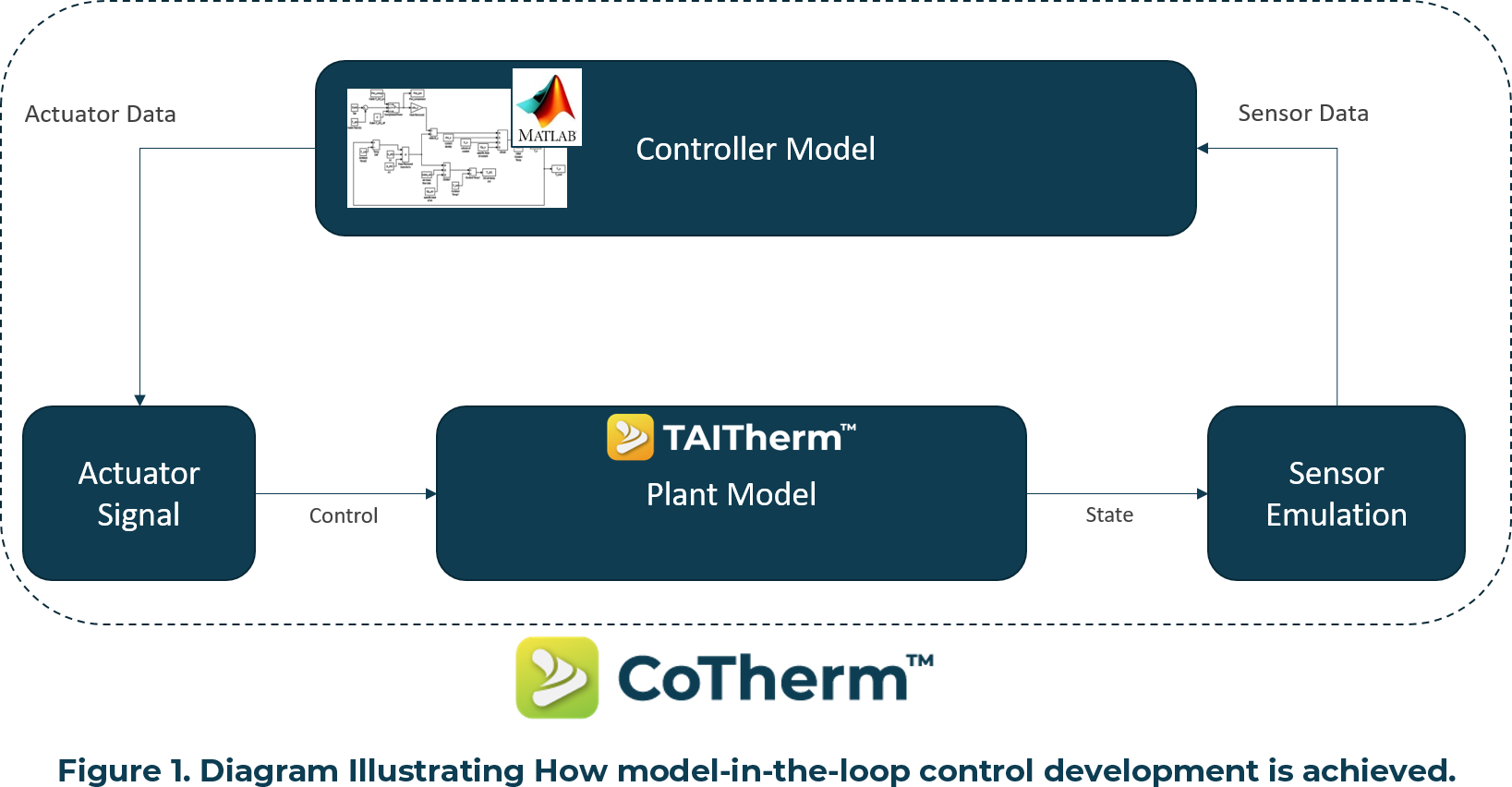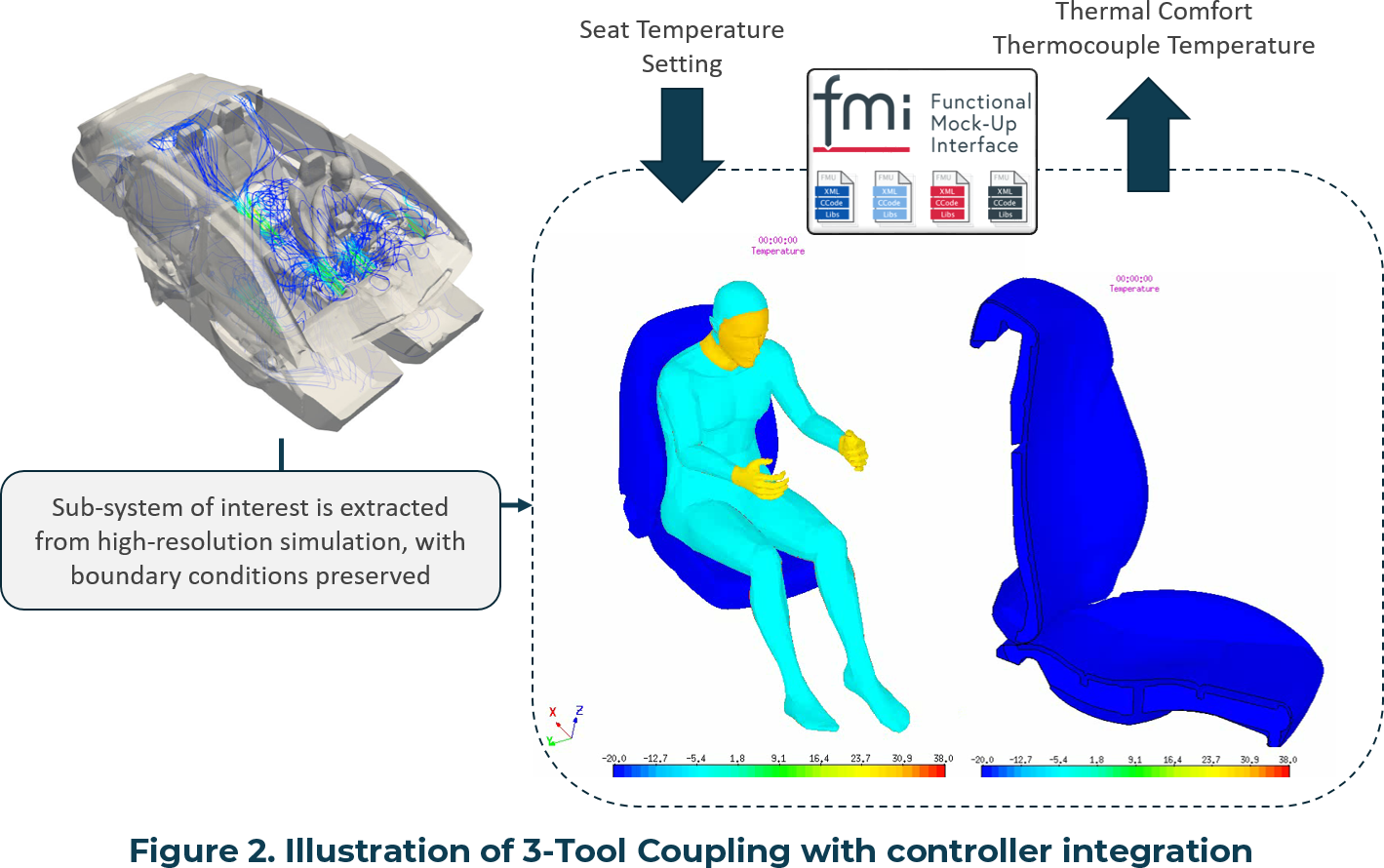It is well understood that the Electric Vehicle (EV) range is a primary consideration in the purchase decision. Effective energy management is critical for managing vehicle range and is, in turn, increasingly reliant on complex and highly integrated controllers. These controllers combine multiple individually controlled sub-systems and link them with higher-level control to minimize energy consumption and maximize range. Engineers have turned to model-in-the-loop (MIL) controller development to develop these controllers. Such exercises aim to use a simulation of the system as a plant model paired with a control system model. These two models are combined to allow engineers to test how changes to the controller interplay with the system's overall performance. Figure 1 shows a representation of this process. This blog post will explore the supporting simulation technologies and methods for leveraging 3D CAE models in TAITherm™ for MIL controller development.

Introduction
There are numerous control systems on modern vehicles. The smallest systems are simple single input and output controllers that control specific design features. These controllers are aggregated into increasingly large systems, for example, the HVAC system, the seat, or the battery. These systems are combined again to create an integrated vehicle controller. At all levels of control, a model of the underlying plant is needed. The plant model can be used to develop controllers before physical system development, which builds confidence in the control system and reduces testing costs. It has been common for control system designers to build models for this purpose. As CAE methods have matured, it has become possible to leverage high-resolution CAE models instead of purpose-built models. Thermoanlytics' software solutions support the development of plant models across various applications. Using an industry-leading transient solver, TAITherm™ provides comprehensive 3D heat transfer modeling, including human thermal comfort, battery performance, and joule heating. TAITherm™ enables the fast and accurate simulation of the full range of transient thermal design problems.
CoTherm™ offers an unrivaled CAE tool linking ability and the ability to create and automate complex CAE workflows. CoTherm™ provides a convenient framework for linking models from various CAE teams into a single environment for complex analysis. For example, a 3D model of a seat can be easily paired with a controller model in Simulink. CoTherm™ simplifies evaluating multiple seats with the same controller, multiple controller variations with a single seat, or testing a seat and controller under various environmental conditions.
Integrated Controller Modeling for Digital Sign-off
Selecting the right CAE tools and model resolution is critical for the digital development of controllers. CoTherm™ enables the linking of multiple CAE modeling domains to develop highly integrated multi-domain simulations for digital sign-off (link: https://support.thermoanalytics.com/hc/en-us/articles/7977652183187-3-Tool-Coupling-for-Predictive-Cabin-Simulation). These methods can be easily extended to include controllers at various levels. Although this approach is suitable for testing vehicle performance, the required computational costs are often too high to be practical for iterative controller development.
Figure 2 shows an example of a 3-tool Coupling. In this case, the AC and HVAC control is being modeled with GT-ISE. The plant model is a coupled simulation combining 3D computational fluids, 3D thermal structure, human thermal sensation and comfort, and the 1D system model in GT-ISE.

Sub-System Controller Development
When the controller is being developed for a sub-system, there is less of a need for highly integrated modeling. Models for this purpose are commonly limited to only the system of interest. This reduction in model scope is used to reduce run times while maintaining accuracy. These models can be used to develop controller tuning parameters under various conditions and assess the design performance simultaneously. An example of this is the controller for a seat heater. A model of the seat cushion, heating elements, and an occupant can be used to develop gains appropriate for a range of initial temperatures based on the accurate digital representation of the heating elements, the seat temperature sensor, and the objective thermal sensation and comfort metrics. The design objective is to find the minimum possible energy with the maximum possible thermal comfort over the expected range of operating conditions.
When working with sub-system models, the FMI open standard is common. This allows TAITherm™ models or CoTherm™ processes to be packaged as a self-constrained unit, known as an FMU. The FMU is typically developed based on detailed CAE models by the 3D CAE analysis team and then delivered to controller development teams for integration into other software. This allows tools like Simulink to call high-accuracy, fast-running plant models directly. Controller engineers can quickly experiment with control strategies and see the direct impact on relevant design metrics. This webinar provides a detailed explanation and some relevant examples of the FMI/FMU method: https://support.thermoanalytics.com/hc/en-us/articles/4402435731987-Using-FMI-to-Combine-System-Models-and-TAITherm-Simulations
Conclusions
High-performing controllers are critical for extending vehicle range. Today’s controllers are complex and exist on many levels of the vehicle architecture. Whether creating whole vehicle thermal management systems, developing battery thermal management systems, or calibrating HVAC controllers, TAI’s experts and industry-leading software are ready to help, no matter what type of system you’re developing. Selecting the right CAE tools is critical for the digital development of controllers: TAITherm™ enables the fast and accurate simulation of the full range of transient thermal design problems. CoTherm ™ offers an unrivaled CAE tool linking ability and the ability to create and automate complex CAE workflows.
If you want to explore simulation technologies and methods for leveraging 3D CAE models in TAITherm™ for MIL controller development, please request a live demo of our software.

Visit our website at suppport.thermoanalytics.com for
- FAQs
- Webinars
- Tutorials

